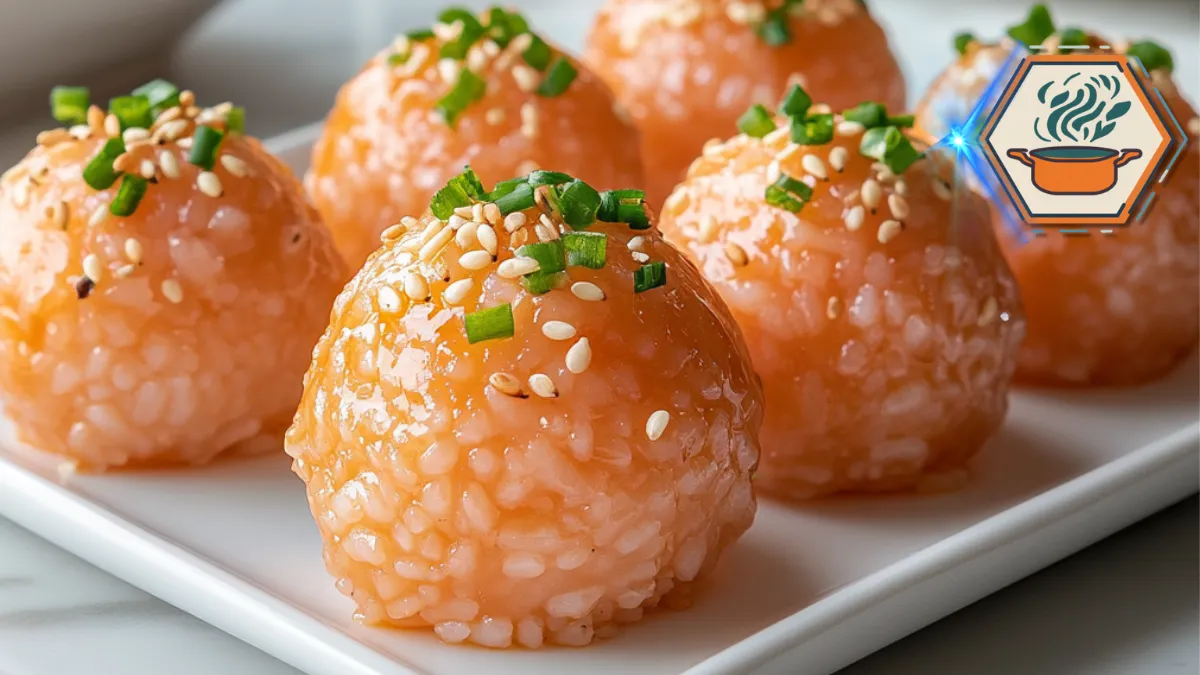Time to read:12 minutes
Table of Contents
Introduction to Salmon Rice Balls
What Are Salmon Rice Balls?
Salmon rice balls, also called onigiri or omusubi, are a well-loved Japanese dish. These are made by shaping rice into triangles or round balls, often filled with seasoned salmon. Usually, a sheet of nori (seaweed) wraps around the rice to add flavor and make it easier to hold. A simple Salmon Rice Balls Recipe is ideal for anyone seeking a quick and healthy snack or meal option.
This dish is popular because it is both simple and versatile. For example, you can enjoy it as a snack, a light lunch, or even a breakfast option. With minimal ingredients and easy steps, salmon rice balls are now a global favorite.
The Origin and Cultural Significance of Salmon Rice Balls
Rice balls have been a part of Japanese food culture for centuries. Originally, farmers and soldiers carried them as portable meals. Since they were easy to transport and filling, rice balls became a practical solution for people who worked or traveled outdoors.
Salmon, which is abundant in Japan, became a favorite filling. It added flavor, nutrition, and variety to the otherwise plain rice. Over time, salmon rice balls gained cultural significance. Today, you can find them in traditional meals, modern bento boxes, and even convenience stores.
Additionally, rice balls are often prepared with care and shared among loved ones. This practice makes them a symbol of comfort and family bonding.
To learn how to create crispy rice textures for an interesting twist, check out our crispy pancake recipe guide.
Key Ingredients Needed for Perfect Rice Balls
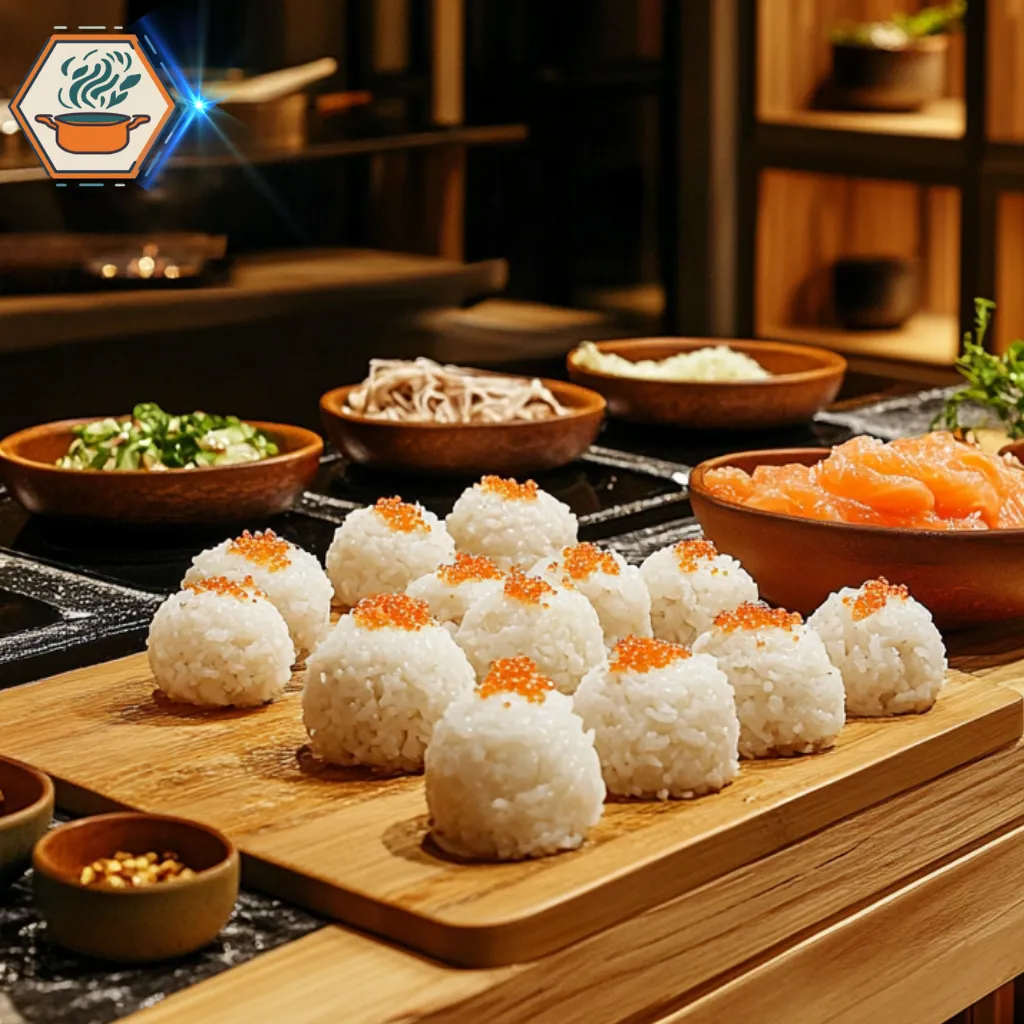
To make the best salmon rice balls, you need a few essential ingredients. Each one plays an important role in achieving the perfect flavor and texture.
- Short-grain rice: This rice is sticky and holds its shape well, making it ideal for rice balls. Long-grain rice, on the other hand, is not recommended.
- Cooked salmon: Grilled, baked, or even canned salmon works well. Lightly season it with salt for a traditional taste.
- Nori (seaweed): Wrapping rice balls with nori adds a savory flavor and helps keep the shape intact.
- Salt: A sprinkle of salt enhances the flavor of the rice and the salmon.
- Optional fillings: Pickled plums, sesame seeds, or cooked vegetables can add variety and extra flavor.
It is important to use slightly warm rice while shaping the balls. Warm rice is stickier and easier to mold, making the process much smoother.
For a unique addition to your recipe, consider incorporating caramelized sugar for a sweet contrast. Read more in our guide to mastering sugar caramelization.
Types of Salmon Used and Their Benefits
The salmon you choose can greatly impact the taste and nutritional value of your rice balls. Here are some popular types:
- Fresh Salmon
Fresh salmon is rich in omega-3 fatty acids and protein. Grilling or baking it enhances its natural flavor and nutritional value. - Canned Salmon
Canned salmon is a convenient and budget-friendly option. Since it is already cooked, you can save time during preparation. - Smoked Salmon
Smoked salmon offers a rich, salty, and smoky flavor. It is perfect for adding a gourmet twist to your rice balls. - Seasoned Salmon
Pre-seasoned salmon, like teriyaki or miso-flavored salmon, can make your rice balls even tastier. However, pair it with plain rice to maintain balance.
Health Benefits of Salmon
In addition to its great taste, salmon provides numerous health benefits:
- Omega-3 Fatty Acids: These essential fats support brain and heart health.
- Protein: Salmon is an excellent source of protein, which helps with muscle repair and growth.
- Vitamins: It is rich in vitamin D, which strengthens bones, and B vitamins, which boost energy.
If you enjoy exploring salmon-based recipes, don’t miss our article on does salmon taste good deep-fried.
Preparation Techniques and Tips for Salmon Rice Balls Recipe
Creating the perfect salmon rice balls recipe requires attention to detail, from selecting the best ingredients to mastering the shaping process. By focusing on these aspects, you can ensure a dish that is both delicious and visually appealing.
Choosing the Right Rice for Your Recipe
Rice is the foundation of any rice ball recipe, making it crucial to choose the right type. Opt for short-grain rice, which has a sticky texture ideal for holding the rice balls together. Here are key points to consider:
- Japanese sushi rice: Known for its stickiness, this rice is perfect for rice balls.
- Rinse the rice thoroughly: Washing the rice removes excess starch, preventing clumping during cooking.
- Cook with the right water ratio: Use a 1:1.1 ratio of rice to water for the best texture. Too much water can make the rice mushy.
For a comprehensive guide on selecting the right rice for sushi, consider exploring Breakthrough Sushi’s article on Which Rice Should You Use for Sushi. This resource provides detailed insights into various rice varieties and their suitability for sushi preparation
Preparing Salmon for Maximum Flavor
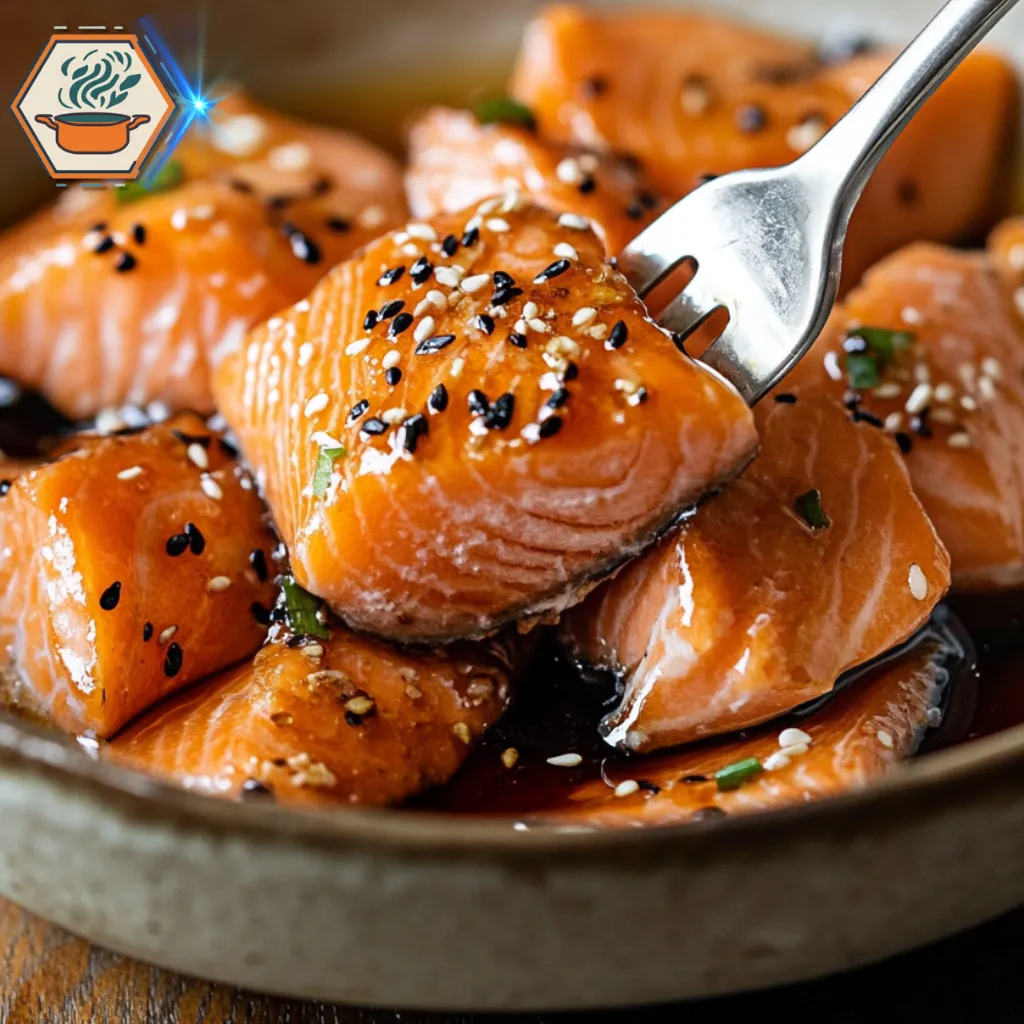
The salmon is the star of this recipe, and preparing it properly ensures maximum flavor. You can use fresh or canned salmon, depending on your preference. Follow these steps for optimal preparation:
- Fresh salmon: Bake, grill, or steam the salmon until fully cooked. Let it cool before flaking it into small pieces.
- Season with care: Mix the salmon with soy sauce, a touch of mirin, or sesame oil to enhance its taste.
- Remove bones and skin: Ensure the salmon is boneless and skin-free for a smoother texture.
Pro tip: For a smoky twist, lightly sear the salmon with a kitchen torch before incorporating it into the rice.
Techniques for Shaping Rice Balls
Mastering the technique of shaping rice balls is essential for a successful recipe. Uniform shapes ensure even cooking and an attractive presentation. Here’s how to do it:
- Wet your hands: Prevent rice from sticking by wetting your hands with water.
- Use a pinch of salt: Rub a small amount of salt onto your palms to add flavor to the rice.
- Add the filling: Place a spoonful of seasoned salmon in the center of a small rice portion.
- Shape into balls or triangles: Gently press and shape the rice around the filling. Avoid pressing too hard, which can make the balls too dense.
Tips to Avoid Common Mistakes
Even experienced cooks can encounter challenges when making salmon rice balls. Here are some common issues and how to avoid them:
- Rice falls apart: This happens when the rice is too dry. Ensure you use sticky short-grain rice.
- Overfilled rice balls: Use a small amount of filling to prevent the rice from splitting open.
- Unbalanced flavors: Taste and adjust the seasoning of the salmon before assembling.
- Uneven shapes: Practice shaping with damp hands for consistent results.
Creative Variations and Additions for Salmon Rice Balls Recipe
Creating a delicious salmon rice balls recipe opens the door to endless possibilities for flavor and creativity. In this section, we’ll explore ways to elevate your rice balls using additional ingredients, alternative preparation methods, and complementary pairings. Whether you want to add vegetables, experiment with seaweed, or craft vegan options, these ideas will help you customize your dish to perfection.
Incorporating Seaweed, Vegetables, and Sauces
Adding extra ingredients such as seaweed, fresh vegetables, and sauces can enhance the flavor and nutritional value of your salmon rice balls recipe. Here’s how:
Seaweed Wraps and Flakes
- Nori Sheets: Wrapping the rice balls in nori sheets adds a savory taste and a crisp texture. Nori is rich in iodine and gives an authentic Japanese touch.
- Seaweed Flakes: Sprinkle dried seaweed flakes on top for an umami boost and vibrant appearance.
Fresh and Cooked Vegetables
- Cucumber and Avocado: Chop these fresh vegetables into small cubes and mix them into the rice for a light and creamy texture.
- Carrot and Bell Peppers: Grated carrots or finely diced bell peppers introduce sweetness and a satisfying crunch.
- Edamame: Adding shelled edamame beans is a great way to incorporate protein and color.
Sauces and Fillings
- Soy Sauce Drizzle: A light drizzle of soy sauce enhances the savory flavors.
- Spicy Mayo: Combine mayonnaise with sriracha for a tangy and spicy kick.
- Teriyaki Glaze: Brush a small amount of teriyaki sauce over the rice balls for a sweet and sticky glaze.
Pro Tip: Pair these additions with fresh herbs like cilantro or scallions to enhance aroma and freshness.
(Looking for more ways to flavor your rice? Check out our guide to making perfect rice.)
Suggested Ingredient Combinations
| Ingredient | Flavor Profile | Suggested Use |
|---|---|---|
| Nori Sheets | Savory, Crisp | Wrap around rice balls |
| Avocado | Creamy, Mild | Mix into rice or use as a filling |
| Chili Flakes | Spicy, Bold | Sprinkle on top or mix into the rice |
| Teriyaki Sauce | Sweet, Salty | Brush over rice balls |
| Pickled Vegetables | Tangy, Crunchy | Serve as a side or garnish |
| Dill | Fresh, Herbal | Mix into rice or sprinkle on top |
You can integrate this table after the “Fresh and Cooked Vegetables” subsection to provide readers with an easy-to-reference guide to ingredients and their applications.
Unique Flavor Pairings with Salmon Rice Balls
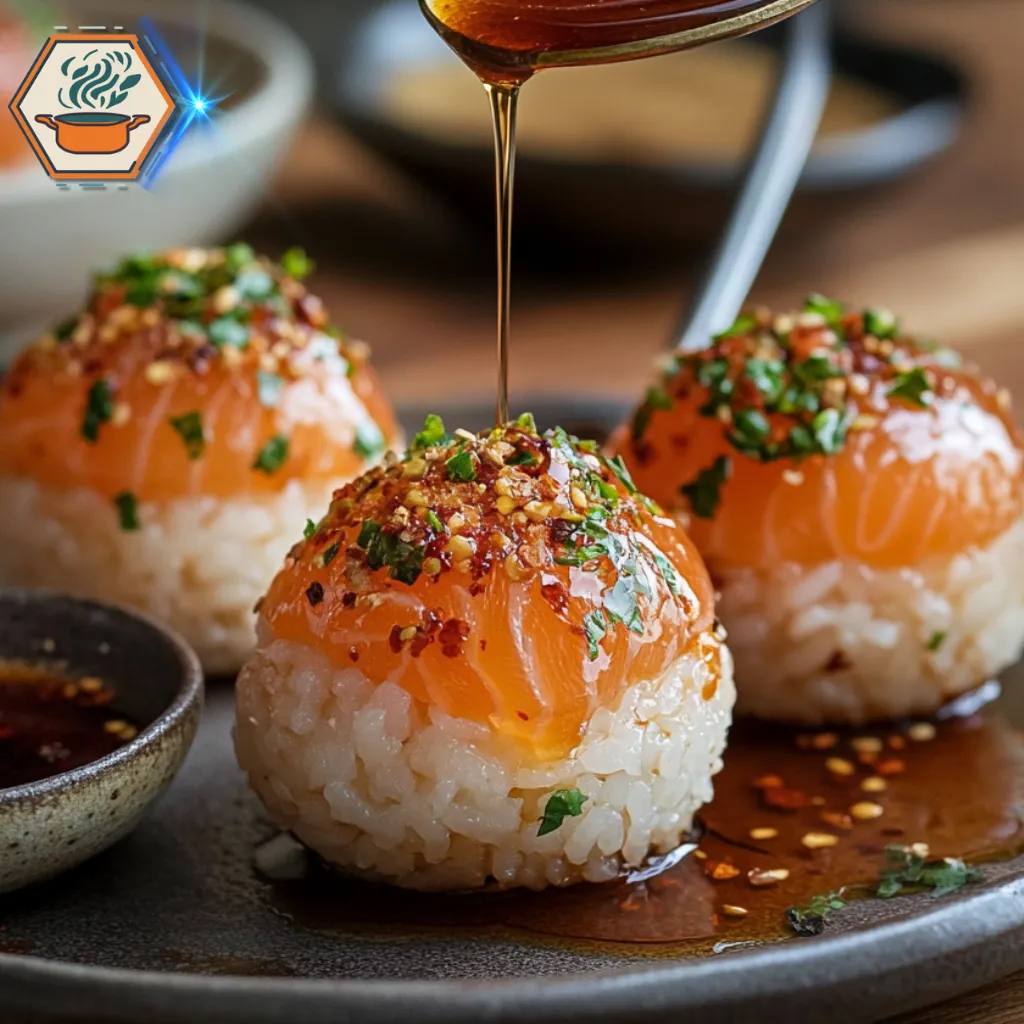
Think beyond traditional flavors to create exciting taste combinations. Salmon’s versatility allows it to shine in both classic and unconventional pairings:
Citrus and Herb Infusion
- Add a squeeze of fresh lemon or lime juice to the rice mixture. The citrus tang balances the richness of the salmon.
- Mix chopped dill or parsley into the rice for a burst of herbal freshness.
Spicy and Sweet Balances
- Sprinkle chili flakes or drizzle chili oil for a spicy kick.
- Use a sweet ingredient like honey or hoisin sauce to balance the heat and complement the salmon.
Cheesy Additions
- Incorporate a small amount of shredded cheddar or cream cheese into the rice for a creamy and indulgent texture.
(Learn how to pair salmon with other complementary flavors in our deep-fried salmon guide.)
Vegan and Gluten-Free Alternatives
To cater to different dietary needs, here are some tips for making salmon rice balls vegan and gluten-free:
Vegan Substitutions
- Replace salmon with mashed chickpeas, marinated tofu, or cooked lentils for a plant-based alternative.
- Use nutritional yeast for a cheesy flavor without dairy.
Gluten-Free Options
- Opt for tamari instead of soy sauce to keep the recipe gluten-free.
- Ensure the rice vinegar or other seasonings used are certified gluten-free.
Pairing Ideas for Complete Meals
Transform your salmon rice balls into a full meal by pairing them with side dishes and beverages. Here are a few ideas:
Light and Fresh Side Dishes
- Miso Soup: A warm bowl of miso soup complements the savory flavors of salmon rice balls.
- Seaweed Salad: Add a refreshing touch with a tangy seaweed salad.
- Pickled Vegetables: Serve with pickled radishes or cucumbers for a contrasting tangy crunch.
Drinks and Desserts
- Green Tea: A soothing cup of green tea pairs perfectly with the rich flavors.
- Fruit Sorbet: End your meal on a sweet note with a light and fruity sorbet.
(Discover more meal ideas in our bone broth preparation guide.)
Storing and Serving Suggestions for Salmon Rice Balls Recipe
When you prepare a delicious Salmon Rice Balls Recipe, proper storage and serving ensure you enjoy their taste and quality for longer. This guide provides clear instructions for keeping your rice balls fresh, reheating them correctly, and making the most of their nutritional benefits.
How to Properly Store Leftovers
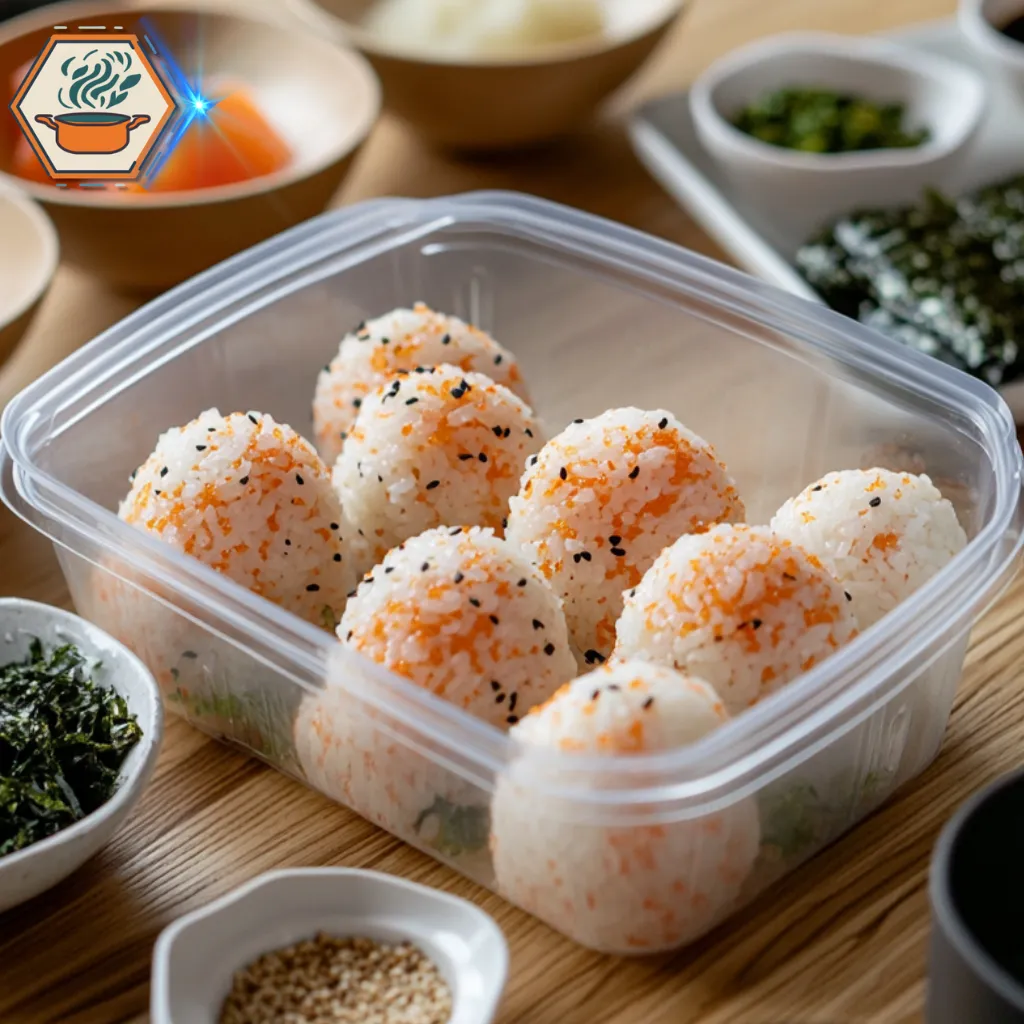
Keeping leftover salmon rice balls fresh is simple with these tips:
- Use an Airtight Container: Place the rice balls in a tightly sealed container. This helps prevent moisture loss and keeps them from absorbing odors.
- Refrigerate Promptly: Store leftovers in the refrigerator within two hours of preparation to maintain freshness.
- Layer with Parchment Paper: If stacking is necessary, separate each layer with parchment paper to avoid sticking.
- Consume Within 2-3 Days: To ensure the best flavor and texture, eat your stored rice balls within a couple of days.
For additional tips on storing rice dishes, you can refer to this bone broth cooking storage guide.
Can You Freeze Salmon Rice Balls?
Yes, freezing is an excellent option for longer storage. Here’s how to freeze them:
- Wrap each rice ball tightly in plastic wrap.
- Place them in a freezer-safe bag, removing as much air as possible.
- Label the bag with the date to track storage time.
Frozen rice balls retain quality for up to one month. Always thaw them in the refrigerator before reheating.
Reheating Techniques to Retain Texture and Flavor
Reheating your salmon rice balls correctly ensures they remain as tasty as when freshly made. Choose from these methods:
Microwave Reheating
- Wrap each rice ball in a damp paper towel.
- Microwave on medium heat for 30-second intervals until heated through.
Steaming
- Use a bamboo or metal steamer.
- Steam for 5-7 minutes, ensuring even heating while preserving moisture.
Pan Frying
- Heat a small amount of oil in a non-stick pan.
- Fry each side for 2-3 minutes for a crispy exterior and warm interior.
Avoid reheating multiple times, as it can lead to texture loss and diminished flavor.
Perfect Occasions to Serve Salmon Rice Balls
Salmon rice balls are versatile and fit various settings, including:
- Lunchboxes: Ideal for school or work meals due to their portability.
- Picnics: A convenient, mess-free snack for outdoor gatherings.
- Dinner Parties: Serve as appetizers or part of a Japanese-themed menu.
- Quick Snacks: Satisfy hunger with a nutritious and filling option.
Pair these rice balls with a light miso soup or a crisp salad for a well-rounded meal.
Nutritional Benefits and Health Tips
Salmon rice balls are not only delicious but also packed with nutrients:
Key Nutritional Benefits:
- High Protein Content: Salmon provides a good dose of protein, supporting muscle health.
- Rich in Omega-3 Fatty Acids: Promotes heart and brain health.
- Energy from Rice: A great source of carbohydrates for sustained energy.
Tips to Boost Health Benefits:
- Add Vegetables: Include shredded carrots or spinach in the filling for extra vitamins.
- Use Brown Rice: Substitute white rice with brown rice for more fiber.
- Limit Sodium: Opt for low-sodium soy sauce to reduce salt intake.
For more information on balancing flavors and health, check out this helpful guide on using tortillas instead of pastry.
By following these storing, reheating, and serving tips, you can make the most of your Salmon Rice Balls Recipe. These delicious snacks are sure to remain a favorite for any occasion!

